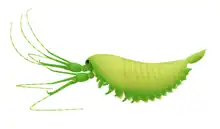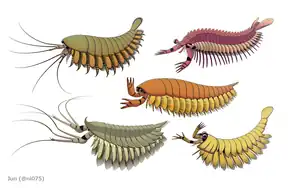Yawunik
Yawunik is an extinct genus of Cambrian megacheiran ("Great appendage" arthropod) known from the Burgess Shale in Canada (Marble Canyon locality).[1] The type species has been named Yawunik kootenayi after the Kootenay, both a geographic area (and National Park, where the fossil was found) and North American First Nation, also known as the Ktunaxa. The genus name is derived from Yawuʔnik̓, the name of a primordial sea monster in Ktunaxa mythology.[2] The fossil dates back to 508 million years ago.[3]
| Yawunik Temporal range: | |
|---|---|
 | |
| Fossil paratype | |
 | |
| Life reconstruction | |
| Scientific classification | |
| Domain: | Eukaryota |
| Kingdom: | Animalia |
| Phylum: | Arthropoda |
| Class: | †Megacheira |
| Order: | †Leanchoilida |
| Family: | †Leanchoiliidae |
| Genus: | †Yawunik Aria et al., 2015[1] |
| Type species | |
| †Yawunik kootenayi Aria et al., 2015[1] | |
Description

Yawunik had large size for megacheiran, up to 11.66 centimetres (4.59 in) long not including great appendage. It had four eyes, in the anteriormost position of the head, and lateral eyes are larger. Yawunik differs from other leanchoilid such as Leanchoilia by having numerous teeth on the last two rami of the great appendage, which were likely used to grasp prey.[1]
References
- Aria, Cédric; Caron, Jean-Bernard; Gaines, Robert (2015). "A large new leanchoiliid from the Burgess Shale and the influence of inapplicable states on stem arthropod phylogeny". Palaeontology. 58 (4): 629–660. doi:10.1111/pala.12161.
- "Creation Story". "Creation Story" on Ktunaxa Nation. Retrieved 20 February 2021.
- Brian Switek (2 April 2015). "Scientists uncover yet another Cambrian weirdo". "Laelaps" on National Geographic. Retrieved 2 April 2015.
